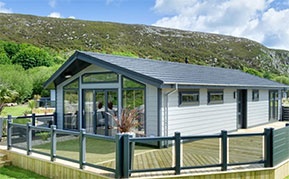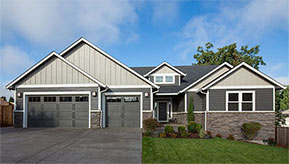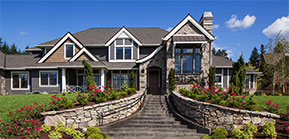Mixing Siding to Define Your Home's Exterior
by Rachel Lyon, Editorial Director for Direct from the Designers™
It can seem overwhelming to put together a coherent exterior design—it’s not just a matter of slathering on some paint and calling it done, and everybody who passes your house will see the final product for years. The pressure is on to create a design that is extraordinary, but the average homeowner just doesn’t have the experience to know how to do anything special with their siding, the largest part of their canvas. As a result, there are a lot of houses out there that are woefully plain.
If your curb appeal is lacking, consider if the architecture of your home calls for a more varied and texturized use of siding. The effect is amazing when done right—your eye is automatically drawn to a dynamic and balanced image, and any passersby will also pause to admire a stylish exterior. You’ll be confident in your decision to use different types of siding once you learn the basics, so here is what you should know!

Determining the Best Style for Your Home
The underlying shape and architectural principles of each home should give clues as to what siding will look good. A lot of this is based on historical background, but individual aesthetics also play a role. No two houses of the same genre or even by the same architect will necessarily look their best with the same siding design.
The simpler the house, the simpler its siding should be to match. For example, boxy styles like traditional ranches and Cape Cods with rectangular footprints and uncomplicated roofs are typically finished with simple horizontal lap siding in one color. On the other end of the spectrum are intricate bungalows and Craftsman houses, which flaunt a range of shapes from their foundations up to their gables. Highlighting different parts of the house with lap, vertical board and batten, and shingle siding in a tastefully contrasting color palette is par for the course in this case.
You should also take location into account to ensure your home fits with its background. Most urban and suburban homes use lap siding, but many trendy areas are leading the charge and showing homeowners that varied exteriors can and do make neighborhoods more beautiful. And if you have a house out in the woods or along a coastline, shingles are the natural choice, even for styles that don’t usually use them. Take everything into account so you can choose siding to fit the whole picture.

Selecting Which Sidings to Use
The three basic siding types give your home horizontal or vertical texture, or a combination of both. Horizontal lap siding is the most widely used by far, and it gives a neat traditional look, but vertical panel or board and batten siding gives you the option to visually stretch your home and make it seem taller. This has been the go-to option for structures like barns for many years, so more farm house owners are deciding that they want to incorporate this rural style because it gives their houses something extra. Finally, shake shingle siding is a classic choice that still finds plenty of use on homes that put forth an organic design, whether that is environmentally or architecturally determined, like with Craftsman and Prairie-style houses.
If anybody only uses one siding, lap is usually chosen, but that’s not the end of it. You can choose smooth or wood grain panels, if you want beaded edges, and from a wide range of colors to make sure your home gets the perfect look. Vertical siding also has options for texture to provide different kinds of dimensionality, and shingles come with staggered or straight edges to imbue the right level of rustic charm. No matter which siding you prefer, you can take it in a formal or natural direction as needed.
When using two or more sidings, see how your home can be divvied up into sections. Does it have gables that give you triangular shapes to work with? Is there a nook or entire room that projects out of the house’s main footprint and is just waiting to be highlighted? Maybe there are widely overhanging eaves that set the porch apart from the rest of the exterior. Don’t try to force it—if it isn’t there, you risk overcomplicating your home’s design. Having a range of siding on a flat surface will look disjointed rather than appealing.
Keeping with the same idea, make sure that if you use different sidings, they are fairly comparable in style. A very simple and smooth lap paired with the most rustic shingles will draw attention because it looks unnatural, but there are many steps in-between that are sensible. You still have plenty of choices!

Balancing the Overall Image
Once you’ve determined your home’s shapes and the siding you want to use, it’s time to put them together. There is no right or wrong way to go about it. Conventional wisdom says to have lap siding form the foundation of the design and to accent around it, but eclectic schemes are just as stunning, if not more so.
Consider what you want to see when you come home. The front door and surrounding trim are the natural focal points of this area, so simpler siding won’t compete. As you move away from the entrance, the design can get more complicated to give the rest of the house personality. Many people choose to accentuate the height of gables with board and batten siding, or put shingles on them for a rustic touch that doesn’t overpower their architecture. For projected spaces that you want to define, board and batten siding is usually favored because it’s not as much of a stylistic jump from lap. Both are composed of larger, longer pieces than shingles. Then think about colors, and make sure each section is obviously distinct. Your exterior can be vibrant without being overly bright, so pick a subdued neutral base and then let your design pop with a bolder hue.
Don’t forget that there are other accents to consider, too. If you want an even more varied exterior, why not consider stone or brick? Either one can be used around the base of the entire house, or you can build them up around a nook to make it stand out. Even a boxy Cape Cod that would look too busy with more than one kind of siding can look amazing with stones around the foundation that evoke a historical look. And for houses that already use other siding, these are another ingredient that can help you create just the right façade.
If you’re ready to delve deeper into the possibilities and want to see products that will help you construct an enviable exterior, take a look at LP® SmartSide® products. Offering durable engineered wood siding in a variety of styles, you’re sure to find amazing options that will make your home something special. Be sure to explore their Application Gallery to see completed projects and get inspired! You’ll find that they have worked with every type of architecture all across the country, and the results are stunning each time.
BROWSE HOME PRODUCT ARTICLES
- Creating a Spa-Like Master Bathroom »
- Designing a Water-Efficient Bathroom »
- Design a Modern Bathroom »
- View All Bathroom Articles »
- Building a New Home »
- Building a Duplex »
- Finding the Right Home Builder »
- View All Building Tips Articles »
- Adding the Right Columns»
- Decorative Touches for Your Interior»
- Shutters for Every Architectural Style »
- View All Columns & Millwork Articles »
- How to Use Specialty Laminates »
- Decorative Touches for Your Home's Interior
- View All Countertops and Surfaces Articles »
- What Goes Into a Great Deck? »
- Decorative Touches for Your Home's Interior »
- View All Decking Articles »
- Choosing Glass for Your Entry »
- Stylish Personas for Your Front Door »
- Using Sidelites and Transoms »
- View All Door Articles »
- Choose Siding for Your Region »
- Get the Most Out of Exterior Paint »
- Mixing Siding to Define Your Exterior »
- View All Exterior Articles »
- Finding the Right Home Builder »
- The Appeal of Small House Plans »
- Choosing the Perfect Floor Plan »
- View All Finding a Home Plan Articles »
- Colorful Flooring for Your Home »
- Designing With Different Widths»
- Chic, Neutral, Gray Flooring »
- View All Flooring Articles »
- Garage Doors That Add Curb Appeal »
- Caring for Your Garage Doors »
- Benefits of Insulated Garage Doors »
- View All Garage Door Articles »
- Reclaimed Products for Your Home »
- Building a Green and Stylish Home »
- Benefits of Building with SIPS »
- View All Green Building Articles »
- Cool Gadgets for Your New Home »
- Creating a Hi-Tech Home »
- Efficient Gifts for New Homeowners »
- View All Home Electronics Articles »
- Improve Your Home's Air Circulation »
- How to Improve the Air Circulation in Your Home »
- View All HVAC Articles »
- Bedrooms Designed for Sleep »
- Selecting a Fireplace for Your Home »
- Crafting a Luxurious Master Suite »
- View All Interior Design Articles »
- Design the Perfect Outdoor Space »
- Dive into a Beautiful Pool »
- Design a Sizzling Outdoor Kitchen »
- View All Outdoor Living Articles »
- Apps to Help You Pick Paint Colors »
- Create the Perfect Mood with Paint »
- How to Read the Color Wheel »
- View All Painting & Decorating Articles»
- Creating a Spa-Like Master Bathroom »
- High-Impact Kitchen Upgrades »
- Creating a Water Efficient Bathroom »
- View All Plumbing Fixtures Articles»
- Cladding That Complements Your Exterior »
- Reasons to Consider Prefinished Siding »
- View All Siding & Cladding Articles»
- All About Solar Powered Skylights »
- Natural Lighting for the Dark Corners of Your Home »
- Design a Better Bedroom with Skylights »
- View All Skylight Articles»

